Understanding Mosquito Behavior: Insights and Implications
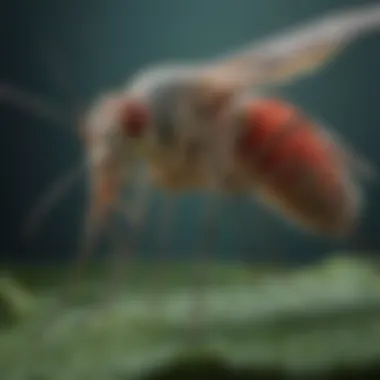
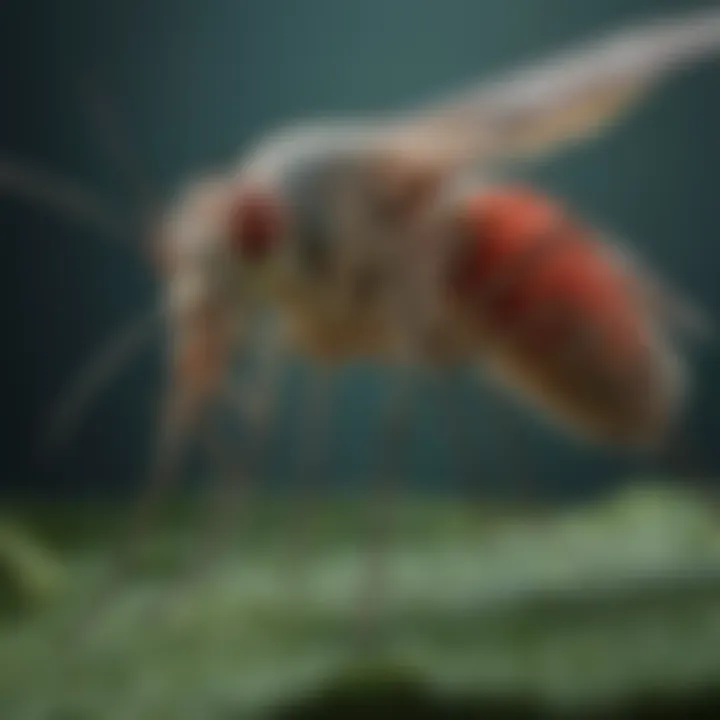
Intro
Mosquitoes, often seen as mere nuisances, harbor a world of complex behavior and biology, particularly when they feel threatened. Understanding these insects goes beyond simple annoyance; it reveals their survival strategies, ecological roles, and interactions with humans. By examining these dynamics, we can grasp the implications for public health and the environment at large. This article will explore various aspects of mosquito behavior and biology, before diving into effective strategies for controlling these persistent pests in our homes.
Preventive Pest Control Strategies
An effective approach to pest management starts with preventive strategies. This proactive mindset addresses potential issues before they escalate into full-fledged infestations. By understanding the specific behaviors of mosquitoes, homeowners can take practical steps to deter them. Here are a few key areas that demand attention:
House Exterior Protection
- Tips for sealing cracks: A home is like a fortress, but even the strongest walls can have tiny breaches. Inspect windows, doors, and walls for cracks or gaps. Caulking or using expansion foam can seal these openings effectively.
- Clearing debris: Overgrown vegetation and accumulated debris creates perfect breeding grounds for mosquitoes. Regular yard clean-up, whether it’s clearing fallen branches or trimming foliage, helps keep these pests at bay.
- Preventing pests from entering: Screens for windows and doors are vital. Ensure they are intact and fit snugly to act as a barrier against entry.
Yard Maintenance
- Essential yard care routines: Keep the yard tidy and well-maintained. Regular mowing, raking, and garden upkeep discourage mosquito habitation.
- Methods for keeping yard pest-free: Planting mosquito-repellent plants like lavender or marigolds adds protection. Additionally, removing standing water is crucial since mosquitoes need it for breeding.
Indoor Cleanliness
- Expert cleaning tips and techniques: A clean home is less appealing to bugs. Regular cleaning, especially all food-related surfaces, can dissuade potential infestations.
- Maintaining a pest-resistant indoor environment: Seal cracks in walls and foundation. Store food in airtight containers and manage waste effectively to eliminate pest attractions.
Garbage Disposal
- Efficient waste disposal methods: Use trash cans with tight-fitting lids, and take out the garbage regularly to eliminate odors that attract pests.
- Importance of proper garbage disposal: Organic waste attracts not just mosquitoes but a slew of other pests. Composting food scraps correctly can help minimize this risk.
Other Pest Prevention Strategies
- Innovative ways to safeguard your home: Consider using yellow bulbs in outdoor lighting. They are less attractive to mosquitoes. Additionally, creating a barrier with citronella candles provides an extra layer of protection during outdoor gatherings.
Identifying Pest Risk Areas
To tackle mosquitoes effectively, one must first determine where they thrive. A thorough inspection can unveil the typical hot spots for these pests.
Moisture Prone Areas Inspection
- Identifying damp conditions: Look for areas in the yard where water tends to accumulate. Moving or filling in these areas can significantly decrease mosquito breeding possibilities.
- Tips for preventing infestations: Ensure gutters are clean and free-flowing to prevent water from pooling.
Crack and Crevice Inspection Guide
- Importance of inspecting access points: Early identification of entry points can save homes from pest invasions.
- Strategies for sealing cracks and crevices: Utilize caulk or weatherstripping to prevent mosquitoes from sneaking in.
Greenery Inspection for Pest Risks
- Understanding greenery's impact on pests: Thick shrubs and dense plants can provide excellent hiding spots. Regular trimming is key in keeping them at bay.
- Guidelines to maintain pest-free yards: Keep plants trimmed and water features clean, reducing attractants.
Additional Pest Risk Areas
- Miscellaneous pest risk areas and preventive measures: Beware of cluttered spaces like garages, sheds, or basements where mosquitoes might hide. Regularly declutter these spaces to minimize risks.
Effective Pest Control Methods
Should preventive measures fall short, it’s time to consider control methods.
Natural Repellents for Pest Control
- Safe and effective natural solutions: Essential oils, like tea tree or peppermint, can be mixed with a carrier oil and applied to skin as a natural repellent.
- Use of essential oils, herbs, and plants: Incorporating plants such as basil or rosemary can add an extra repelling boost to any garden.
Chemical Sprays for Pest Control
- Safe usage of professional sprays: If opting for chemical solutions, be sure to use them as per instructions. Generally, sprays with DEET or picaridin are effective against mosquitoes.
- Eradicating pests with chemical solutions: Regular application during peak seasons can drastically reduce populations.
Pest Traps: Effective Pest Control Solutions
- Setting up and using pest traps: Use traps strategically around the property, particularly in damp areas. It helps capture mosquitoes effectively.
- Capturing and removing pests safely: Dispose of traps safely and replace them as needed.
Biological Control Methods for Pest Prevention
- Using natural predators for pest management: Introducing mosquito fish to water features can help control mosquito larvae naturally.
- Environmental-friendly pest control techniques: Consider methods that align with a sustainable lifestyle to ensure ecological balance.
Other Pest Control Methods
- Innovative pest control methods beyond traditional options: Employing maintenance like professional pest management services could also help set up preventative barriers against mosquito populations.


Prelude to Mosquito Behavior
Understanding mosquito behavior is crucial in grasping the subtleties of their lifecycle, especially when talking about aggression and defense mechanisms. While many might regard these tiny creatures as mere nuisances, their behaviors provide significant insights into their adaptability and survival strategies within the ecosystem. In this discussion, we delve into specific elements that shape their interactions with humans and the environment, exploring how these dynamics influence public health and ecological balance.
Understanding Mosquito Species
To truly comprehend mosquito behavior, we must first recognize the diversity among species. There are around 3,500 species of mosquitoes, each with its own behavioral traits, ecological roles, and life cycles. Notably, Aedes aegypti and Anopheles gambiae dominate discussions around health risks due to their association with diseases like dengue fever and malaria.
Mosquitoes exhibit a range of adaptation mechanisms; for instance, some species are diurnal, feeding during the day, while others prefer the cover of darkness. This distinction is not just a simple preference—it plays a vital role in their survival and impact on human populations. Specific species also show unique preferences for particular hosts based not only on scent but also on temperature and carbon dioxide levels. This behavior can influence the effectiveness of control measures—further highlighting that not all mosquitoes are created equal.
General Life Cycle of Mosquitoes
The life cycle of mosquitoes is a remarkable journey that highlights their resilience and adaptability. Typically, the cycle unfolds in four stages: egg, larva, pupa, and adult. Understanding this lifecycle is pivotal in tackling mosquito populations effectively.
- Egg: Female mosquitoes lay eggs in stagnant water, often in clusters called rafts. This strategic choice ensures that, once hatched, the young larvae have an immediate habitat for growth.
- Larva: The larvae, or wigglers, thrive in water, feeding on organic material. During this stage, they go through several molts, growing increasingly larger and more mature.
- Pupa: The pupal stage is a transitional phase where the mosquito undergoes metamorphosis. Unlike larvae, pupae do not feed, instead resting in the water while they develop.
- Adult: Upon emerging, the adult mosquito is ready to start the cycle anew. Female mosquitoes require a blood meal for reproduction, a necessity that brings them into conflict with humans and other animals.
The environmental conditions largely influence each stage of life. Temperature, humidity, and the availability of hosts play pivotal roles in determining the survival of the different life stages.
"The more we learn about mosquitoes, the clearer it becomes that their lifecycle is not just a series of stages; it’s a complex interplay with the ecosystems they inhabit."
As we move through the narrative of the mosquito lifecycle, this understanding can aid in community awareness, prevention programs, and overall management strategies that can mitigate their impact on human life. Each stage presents specific opportunities and challenges for control measures, emphasizing the importance of targeted strategies.
Triggers of Aggression in Mosquitoes
Understanding what triggers aggression in mosquitoes is essential for both scientific inquiry and practical applications. Mosquitoes are not just passive creatures; they respond vigorously to perceived threats and environmental changes. This section aims to dissect these triggers and their significance, especially for those interested in pest management and the natural behavior of these insects.
Environmental Stressors
Mosquitoes are remarkably sensitive to their surroundings. Environmental stressors can stem from various sources, including climate, habitat alteration, and even chemical pollutants.
- Temperature Fluctuations: When temperatures rise or drop significantly, mosquitoes may become agitated. Warmer weather can speed up their development and increase reproductive rates, while cold snaps may force them into a defensive posture as they seek shelter.
- Humidity Levels: Humidity is crucial for mosquitoes. Low humidity can cause dehydration, prompting mosquitoes to become aggressive in their search for water sources. They may venture into residential areas where water is abundant, resulting in increased human interactions.
- Urbanization: The encroachment of urban structures into their natural habitat creates confusion. Mosquitoes may respond with aggression as they compete for living spaces and resources, leading them to frequent homes where they wouldn't normally go.
These environmental stressors not only affect their behavior but can also subtly shift their breeding habits and preferred feeding times, impacting their interactions with humans and other animals.
"Stress can push mosquitoes to hunt more aggressively, searching for blood meals to compensate for the challenges they face in their environments."
Human Interaction and Provocation
Humans themselves have a significant hand in provoking mosquito aggression, often without realizing it. Actions and behaviors play a critical role in how and when mosquitoes behave aggressively.
- Body Heat and Carbon Dioxide: Simply being in close proximity to mosquitoes generates heat and carbon dioxide, two primary attractants. When these insects detect elevated levels of these stimuli, they often increase their pursuit, leading to potential bites.
- Chemical Signals: Humans exude various scents through sweat, skin bacteria, and even perfumes. Substances like lactic acid can heighten mosquito attraction and may inadvertently provoke their aggressive feeding behavior.
- Disturbances: Rapid movements or swatting can agitate mosquitoes further. If disturbed, mosquitoes feel threatened and may react aggressively, increasing their likelihood of biting out of a defensive instinct.
By recognizing these triggers, homeowners can adopt strategies to minimize mosquito encounters. Simple acts like wearing loose-fitting clothing, utilizing mosquito repellents, and ensuring that the areas around homes are free from standing water can make a marked difference in keeping these pests at bay.
Overall, the exploration of these triggers illustrates a complex interaction between mosquitoes and their environments—an understanding that can help manage their populations more effectively.
Physiology of Mosquitoes when Ticked Off
Understanding the physiology of mosquitoes when they feel threatened is crucial for comprehending their overall behavior, particularly when their usual survival instincts kick in. The way mosquitoes react physically can give us insights into their adaptations and survival strategies in a world where they face numerous predators and environmental challenges. When these insects feel provoked, it’s not just a mere annoyance; it’s a complex series of physiological changes that can influence their aggressive behaviors and interactions with both humans and the ecosystem.
Changes in Reflexes and Reactions
When a mosquito is irritated or threatened, its reflexes undergo noticeable changes, making it more adept at responding quickly to potential dangers. This heightened state of alertness is not a trivial matter; it can be the difference between life and death for these insects.
- Agility Increases: A ticked off mosquito can maneuver deftly, darting this way and that in a blink, avoiding swats or other predators. This agility is a response mechanism to physical threats, optimized over countless generations.
- Sensory Heightening: In moments of stress, their sensory receptors become sharper. They can detect scent changes in the air or vibrations far beyond the capacity of a human's five senses. Typically, a mosquito employs these abilities to locate hosts for blood meals, but when agitated, they concentrate on evasion.
- Speed: A mosquito under distress tends to speed up its flight patterns. Each rapid flutter is powered by a surge of energy, allowing them to escape perceived dangers more efficiently.
Such changes illustrate that a mosquito’s behavior is closely tied to its physiological state during stressful moments. It showcases a blend of instinct and adaptation, providing a fascinating lens through which to view these often-maligned insects.
Chemical Responses and Hormonal Changes
When mosquitoes encounter threats, they experience various chemical and hormonal changes that drive their behavior. Hormonal shifts can dictate how a mosquito reacts in these scenarios, impacting their ability to survive.
- Stress Hormones: Similar to mammals, mosquitoes release hormones that regulate stress responses, often resembling adrenaline in humans. This hormonal cocktail prepares them for a ‘fight or flight’ response, influencing their motor functions and enhancing their agility.
- Pheromone Release: When provoked, mosquitoes can emit pheromones that signal danger. This chemical communication can alert other mosquitoes nearby to the threat, prompting them to be on their guard as well. Such collective awareness is crucial, especially in environments where threats are prevalent.
- Metabolic Changes: Chemical responses also trigger shifts in metabolism, giving them an extra burst of energy for quick movements. This surge allows mosquitoes to dart away faster than usual, increasing their odds of survival.
In summary, when a mosquito feels ticked off, it’s not just a whimsical reaction. It's a highly organized physiological protocol tailored by millions of years of evolution. The understanding of these changes sheds light on their intricate life cycles and behaviors, reinforcing their role in the ecosystem, even if largely seen as pests.
Important Insight: A mosquito's physiological reactions to provocation reveal a lot about its complex interactions with the environment, showcasing not just the challenges they face but also their remarkable adaptability.
Competitive environments shape mosquitoes, and their behavior reveals much more than annoyance; it reflects their evolutionary journey and adaptation tactics. Understanding these dynamics aids in the broader context of mosquito population control and public health strategies.
Ecological Implications of Mosquito Behavior
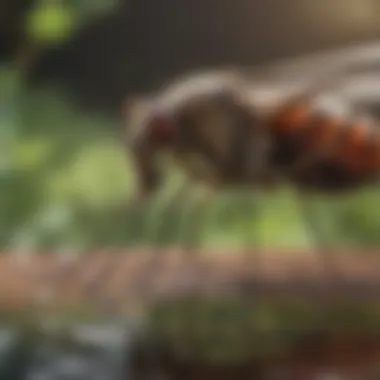
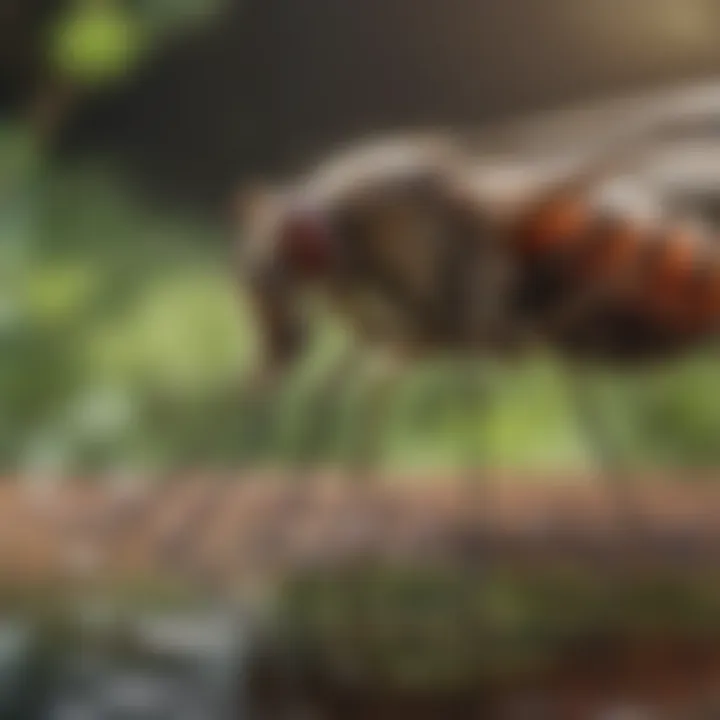
Understanding the ecological implications of mosquito behavior goes beyond the annoyance they bring during summer nights. These tiny creatures play pivotal roles in their environments, and their interactions with other species can reveal fascinating insights into ecosystem functions. Mosquitoes, particularly when riled up, exhibit behaviors that can significantly affect food chains, biodiversity, and the overall balance within various habitats. These dynamics are essential for housewives and homeowners alike to understand, especially when considering the broader impacts on their gardens and local natural systems.
Role in Food Chains and Biodiversity
Mosquitoes, while often labeled as pests, hold an interesting position within food chains. They are not only a food source for many animals but also serve as a key player in maintaining ecological balance. These insects are larva nourish fish, birds, and other aquatic inhabitants as they develop in water bodies. As adults, they also feed numerous species, ranging from bats to amphibians, which rely on them as a primary source of nutrition.
In fact, the intricate web of life around common mosquito breeding sites hints at their critical role in supporting biodiversity.
- Aquatic Ecosystem Impact: Mosquito larvae thrive in still water environments, often emerging from ponds or bogs. These habitats sustain various fish, frogs, and insects that thrive alongside. When mosquito populations fluctuate, they can lead to shifts in these communities, stirring potential overpopulation or scarcity of other species.
- Effects on Pollination: Surprisingly, adult mosquitoes are attracted to nectar from flowers. While they aren’t as effective as bees, they do contribute to pollination efforts. This connection highlights their unexpected role in promoting plant diversity, which in turn supports the entire ecosystem.
"Mosquitoes might seem trivial, but their existence underscores a larger story of interdependence in nature."
Understanding the contribution of mosquitoes towards food chains unveils a crucial aspect often overlooked. It’s a reminder that each organism, big or small, carries a weight in the intricate dance of life within ecosystems.
Impact on Other Species and Ecosystems
Mosquito behavior, especially when agitated or under threat, can alter interactions with other species and disrupt ecosystems. Some points to consider:
- Intensified Predation: When mosquitoes feel pressured, such as by environmental changes or human activity, they may modify their behavior, becoming more elusive or aggressive. This can affect their availability as prey for predators, potentially leading to a ripple effect in the food web.
- Disease Dynamics: Perhaps more concerning is the potential for aggression to enhance disease transmission. Diseases birthed by mosquitoes, such as malaria or dengue, not only affect humans but can also cross species barriers, impacting wildlife populations too. This interconnectedness means that a rise in mosquito-borne diseases can provoke ecological imbalance, leading some species to decline while others may thrive.
- Ecosystem Services Disruption: Mosquitoes contribute to nutrient cycling and organic matter breakdown. Generally, dead mosquitoes are decomposed by various organisms, returning nutrients to the soil and fostering healthier ecosystems. Disruption of mosquito populations—whether from aggressive behavior or control measures—can alter these essential processes.
In summary, the ecological implications of mosquito behavior are far-reaching. Their role as prey, pollinators, and as carriers of diseases intricately ties them to both local and wider ecological landscapes. Understanding these relationships can help mitigate their negative impacts while appreciating their essential contributions to environmental health.
Mosquitoes and Public Health
Mosquitoes are often seen as tiny nuisances, but the reality is far more complex. These insects play a significant role in public health, primarily through the diseases they transmit. Understanding the connection between mosquitoes and health is crucial, especially for housewives and homeowners who want to protect their families.
Diseases Transmitted by Mosquitoes
Mosquitoes are infamous for being vectors of several serious diseases. The most notable ones include:
- Malaria: Caused by parasites carried by female Anopheles mosquitoes. It leads to severe illness and, in some cases, death.
- Dengue Fever: Spread by Aedes mosquitoes, this illness can result in high fever, severe headache, and joint pain, sometimes leading to hemorrhagic complications.
- Zika Virus: A lesser-known but dangerous disease also transmitted by Aedes mosquitoes, Zika can cause birth defects and other neurological problems.
- West Nile Virus: Found in many parts of the world, the West Nile virus is transmitted by Culex mosquitoes and can lead to severe neurological conditions.
- Chikungunya: This is another Aedes-borne virus, known for causing debilitating joint pain, and while rarely fatal, its impact on quality of life is significant.
It's vital to stay informed about these diseases because they can be just a bite away. Preventive measures can dramatically lower the risk of contracting these infections.
Strategies for Mosquito Control
Given the plethora of diseases mosquitoes carry, implementing effective control strategies is essential. Several approaches can be utilized by homeowners to mitigate mosquito populations around their homes:
- Remove Standing Water: Mosquitoes require water to breed, so eliminating any standing water sources, like clogged gutters, bird baths, or plant saucers, can substantially reduce their numbers.
- Use Mosquito Repellents: Applying DEET-based or natural repellents on exposed skin can provide a barrier against bites, making outdoor summer evenings more enjoyable.
- Install Screens: Having screens on windows and doors can prevent mosquitoes from entering the home.
- Encourage Natural Predators: Birds, bats, and dragonflies feast on mosquitoes. Planting flowers and landscaping in a way that invites these natural predators can help keep populations in check.
- Fumigation and Spraying: Local health departments often carry out aerial spraying to control large populations. Homeowners can also hire professionals for targeted treatments.
"Public health initiatives that focus on education and prevention can drastically change the landscape of mosquito-borne diseases."
Taking these steps not only safeguards families but also contributes positively to the community's overall health.
Cultural Perceptions of Mosquitoes
Understanding how different cultures perceive mosquitoes is essential as it reveals the often contradictory roles these insects play in human perception. While mosquitoes are widely seen as pesky nuisances, various cultures view them through unique lenses that can inform local attitudes towards both conservation and control methods. These perceptions shape our interactions with them, impacting everything from public health measures to ecological understandings.
Symbolism in Various Cultures
In numerous cultures, mosquitoes evoke diverse symbols. For instance, in many Indigenous cultures in South America, mosquitoes are seen not just as annoying insects but as integral components of the ecosystem. They are often associated with the cycle of life, representing both the fragility and resilience of nature. In these societies, there is an understanding that every creature has a role to play, no matter how small.
Conversely, in Western societies, visceral reactions dictate that mosquitoes symbolize disease and discomfort. This perception often leads to campaigns focused solely on eradication rather than understanding.
- In Thailand, mosquitoes are part of folk medicine, where bites are believed to be a bargain with nature, bringing blessings of health in exchange for the discomfort.
- While in the United States, they are viewed primarily as vectors of diseases like West Nile virus and Zika, compelling society to prioritize mosquito control over ecological awareness.
How Culture Shapes Attitudes Towards Mosquitoes
Cultural attitudes play a substantial role in how communities approach mosquito management and coexistence. In regions where mosquitoes are viewed positively, such as in parts of Africa, communities often use natural repellents and maintain ecological balance.
In contrast, more industrialized nations exhibit a predominantly antagonistic view, leading to aggressive extermination strategies. The societal impulse to eliminate these insects leads to a reliance on chemicals that may disrupt local ecosystems and harm beneficial insects.
- Education about the ecological roles of mosquitoes is often lacking in these areas, fostering only fear and intolerance.
- Additionally, cultural narratives surrounding environmental fragility can either promote biodiversity or fuel harmful eradication practices.
The implications of these attitudes stretch far beyond just discomfort; they shape public policy on health, environmental management, and even tourism. For instance, awareness programs that highlight the ecological importance of mosquitoes can help shift perceptions and encourage sustainable practices.
"Cultural depth shows us that perception often dictates our reality—what we fear becomes our response, and educating is the key to changing both."
As we navigate the complexities of vector management and public health, cultural perceptions of mosquitoes warrant careful consideration. They influence community designs, ecological literacy, and environmental justice initiatives, underscoring the need to foster a balanced dialogue about both the risks and the important ecological roles of mosquitoes.
Scientific Advancements in Mosquito Research
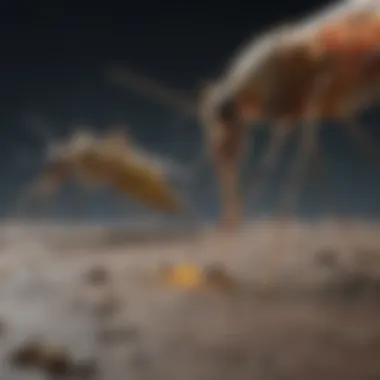
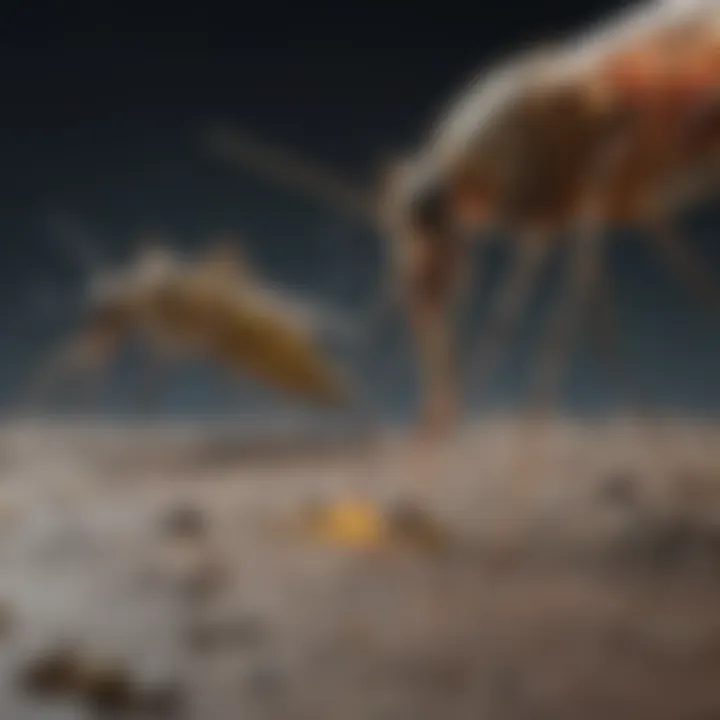
Research on mosquitoes has become increasingly sophisticated, shedding light on their behavior, genetics, and ecological roles. This section explores how scientific advancements are altering our understanding of mosquitoes, particularly when they are provoked or threatened. These innovations pave the way for new control methods, which can significantly affect public health and environmental balance.
Recent Innovations in Genetic Studies
In recent years, genetic studies of mosquitoes have made headlines in the scientific community. One key advancement is the use of CRISPR technology to edit genes in Aedes aegypti, the primary vector of dengue and Zika viruses. By targeting genes that control reproduction, scientists are exploring ways to reduce mosquito populations in a precise manner.
For instance, researchers at the University of California, Davis have successfully engineered male mosquitoes that produce offspring incapable of reaching maturity. This technique not only helps in controlling the population but also minimizes reliance on chemical pesticides, which can be harmful to the environment and non-target species.
Benefits of Genetic Innovations:
- Increased effectiveness of mosquito population control efforts
- The potential to reduce virus transmission rates
- Fewer environmental impacts compared to traditional methods
However, while genetic modification offers promising results, it raises a host of ethical and ecological considerations. For instance, what happens to the ecosystem if a mosquito species is completely eradicated? Besides, public perception and regulatory hurdles can also complicate genetic research.
Technological Approaches to Control Mosquito Populations
As technology continues to advance, so too do the strategies involved in mosquito control. One of the most notable technological advancements is the use of drones for monitoring mosquito populations and habitat mapping. Drones can efficiently gather data over wide areas, identifying breeding sites that are hard to access otherwise.
Another exciting technological method includes the use of smart traps that utilize attractants combined with sensors. These traps not only catch mosquitoes but also provide data on species composition and population density. This real-time data helps in making dynamic control decisions.
Technological Innovations in Detail:
- Drones for Mapping: Quick aerial surveys to pinpoint breeding spots.
- Smart Traps: Combination of lures and sensors for efficient monitoring.
- Mobile Apps: Applications enable citizens to report mosquito sightings, enhancing community involvement.
These technologies signify a shift towards more integrated mosquito management strategies, enhancing the understanding of mosquito behavior and their ecological impact.
"With these advancements, we are shifting away from outdated practices, and instead fostering solutions grounded in precise data and ecological considerations."
Overall, as we continue to navigate the complex interactions between mosquitoes and their environments, these scientific advancements offer fresh perspectives and solutions. Armed with innovations in genetics and technology, we stand a better chance at managing mosquito populations effective and sustainably.
Public Awareness and Education
Raising awareness about mosquitoes goes beyond mere repulsion; it encompasses understanding these creatures, their behaviors, and the implications of their presence in our environments. Education plays a vital role in shaping attitudes towards mosquitoes and aids in developing effective management strategies. An informed public is better equipped to handle the challenges posed by mosquitoes, especially when they become aggressive due to environmental or anthropogenic stressors.
A solid grasp on mosquito behavior can lead to more effective solutions for managing populations and reducing public health risks. By recognizing the signs of mosquito aggression, homeowners and communities can take timely actions to mitigate potential outbreaks of mosquito-borne diseases. For instance, if people understand that standing water can be a breeding ground, they might be more proactive about drainage and cleaning their yards.
Educating the public on the life cycle of a mosquito also underscores the importance of eliminating breeding sites. Here are some key points to consider:
- Understanding Development: Knowing the life stages—from egg to larva to adult—can aid in pinpointing the most effective times for intervention.
- Predicting Behavior: Awareness of which species are prevalent in specific areas can influence personal precautions, such as using repellent more diligently during peak seasons.
- Health Connections: Numerous diseases stem from mosquito bites, reinforcing the notion that education can save lives. Recognizing symptoms and knowing when to seek medical help can be crucial.
"An informed community is a resilient community. Without knowledge, we’re just waiting for the next bite."
Improving Understanding of Mosquito Behavior
Improving understanding of mosquito behavior requires clear communication of the natural instincts that drive them. Mosquitoes are not mindless pests; they are equipped with sensory mechanisms to detect carbon dioxide and body heat. Such insights can help homeowners take precautions, such as eliminating attractants. This involves understanding that certain scents can draw mosquitoes closer, while others can repel them.
Moreover, educating households about the variations in mosquito species paths offers knowledge that can be leveraged to reduce invasion effects. For example, the Aedes aegypti mosquito thrives in urban settings next to humans, while other types may prefer more rural, stagnant water habitats. Both possess unique aggression triggers and behaviors that deserve attention when concocting mosquito management strategies.
Community Involvement in Mosquito Management
Community involvement can be a game-changer in effective mosquito management. When residents come together, they can implement community-wide initiatives to control mosquito populations. These could include neighborhood cleanup days focusing on removing standing water or using larvicides responsibly in ponds or pools that can't be drained.
Additionally, local workshops can empower community members with knowledge about safe mosquito repellent alternatives. Ideas for becoming a community advocate against mosquitoes include:
- Organizing Educational Campaigns: Sharing information on social platforms about reducing mosquito breeding.
- Collaboration with Local Health Departments: Engaging with experts to learn about recent findings and disseminating relevant information to the community.
- Creating a Reporting System: Encourage residents to report stagnant water bodies and evidence of mosquito breeding to local authorities.
Ultimately, the more that community members educate themselves and work collaboratively, the more effective they will be in managing and controlling mosquito populations.
Ending and Future Directions
Understanding the behavior and life cycle of mosquitoes, particularly when they feel threatened, is vital. This article sheds light on how these small creatures can impact human life and the environment substantially. It's not merely one of those studies best suited for scientists locked in labs; the insights drawn here resonate with everyday life experiences for homeowners and families.
The Importance of Continued Research
Continued research on mosquitoes is not just a necessity; it's a smart investment for the future. The role these insects play in transmitting diseases is alarming. In the U.S., conditions like Zika and West Nile Virus are reminders of how a tiny mosquito can impact public health. A focus on their biology and behavior allows scientists to develop efficient control measures. Some examples of ongoing research include:
- Genetic Manipulation: Altering the DNA of mosquitoes to prevent them from breeding or transmitting diseases.
- Behavioral Studies: Observing how changes in climate affect mosquito activity patterns, leading to timely preventative actions.
- Public Awareness Campaigns: How knowledge can empower communities to engage in effective mosquito control, thus protecting their households.
As long as mosquitoes exist, we must stay ahead of their evolutionary tactics to ensure public safety and health.
Implications for Ecosystem Management
An understanding of mosquito behavior directly influences ecosystem management strategies. These insects fit into a larger web of life, and their population dynamics can alter other species' survival, ranging from fish to birds. Recognizing this permits us to take a more holistic approach to conservation efforts. Here are some implications to consider:
- Biodiversity Maintenance: Mosquitoes serve critical roles as pollinators and as a food source for many species. A drastic decline in their numbers could disrupt local ecosystems.
- Integrated Pest Management (IPM): Utilizing knowledge about mosquito behavior and lifecycle can lead to better-informed IPM strategies, promoting a balance that does not rely heavily on chemical pesticides.
- Habitat Restoration: Addressing factors that contribute to overpopulation, like stagnant water bodies created by human activity, can lead not just to fewer mosquitos, but a healthier ecosystem overall.
In summary, recognizing the multifaceted roles mosquitoes play and the potential[ consequences of their behavior will enrich ecosystem management efforts. This sets the stage for a thoughtful approach to coexistence, where human interests and ecological integrity can harmonize for mutual benefit.



